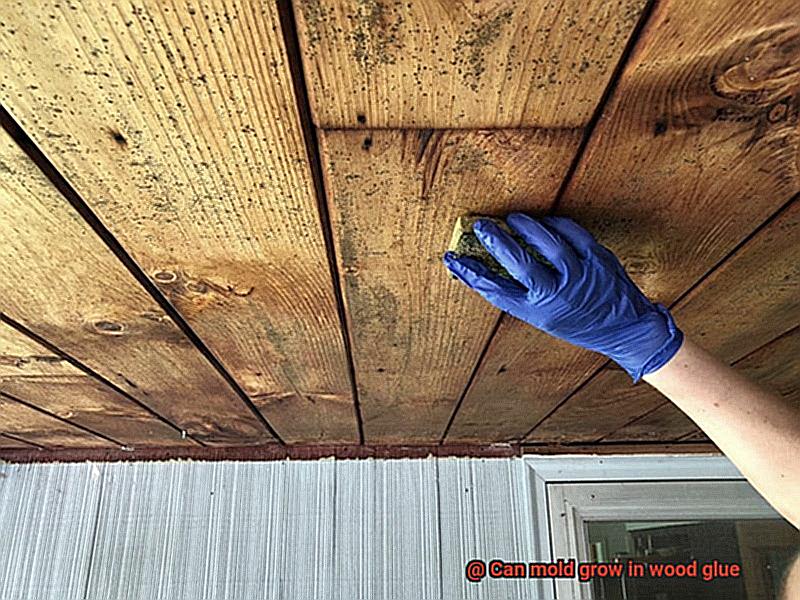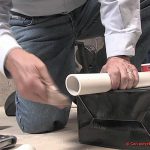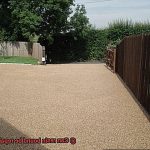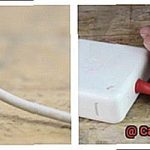Today, we’re tackling a burning question that’s been circulating in the woodworking community: Can mold really grow in wood glue? We all know how annoying mold can be – it creeps into damp corners, leaving behind ugly stains, funky smells, and even health risks.
But what about our beloved wood glue? Is it safe from this sneaky fungus?
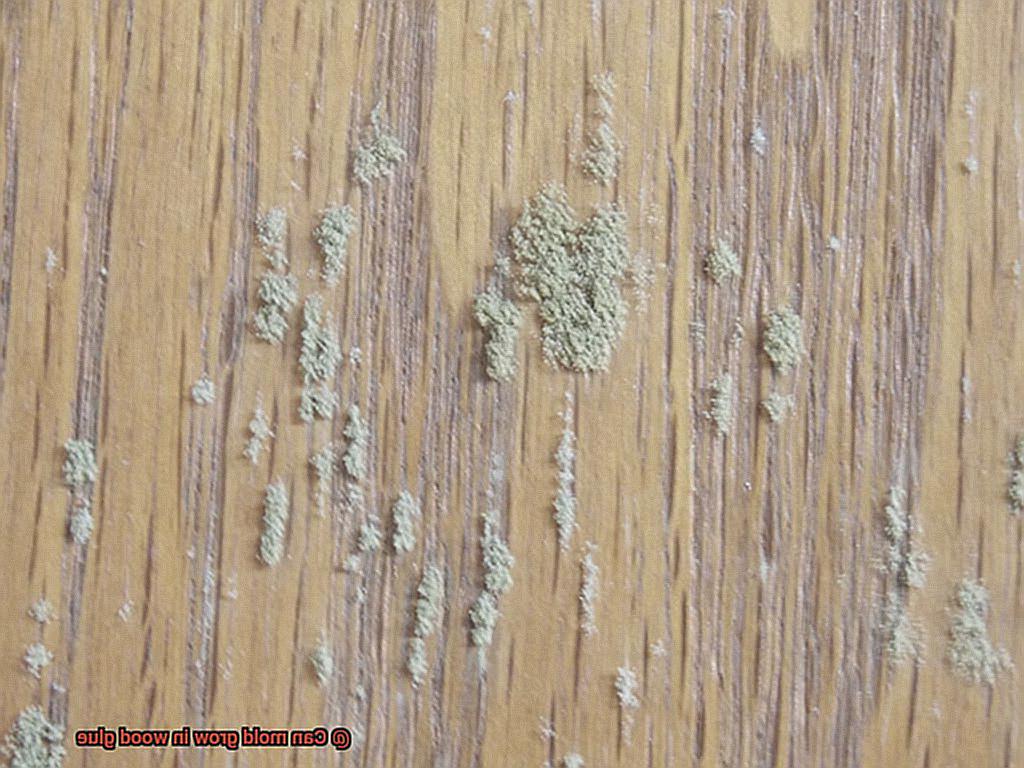
Well, get ready because we’re about to uncover the truth. Whether you’re a pro builder or simply enjoy tinkering with home projects, understanding the potential risks and benefits of mold growth in wood glue is a game-changer.
So, grab your favorite brew, kick back, and join us on this exciting exploration of the fascinating world of mold and wood glue.
What is Wood Glue?
Contents
- 1 What is Wood Glue?
- 2 What is Mold?
- 3 Can Mold Grow in Wood Glue?
- 4 Factors that Contribute to Mold Growth in Wood Glue
- 5 How to Prevent Mold Growth in Wood Glue
- 6 Moisture-Resistant and Waterproof Wood Glues
- 7 Proper Ventilation and Drying of Surfaces
- 8 Sealing Bonded Surfaces with Protective Finish
- 9 Conclusion
Wood glue, also known as carpenter’s glue or woodworking adhesive, is a remarkable adhesive that serves as the backbone of woodworking projects. With its unique formulation, wood glue is specifically designed to bond wood surfaces together, creating strong and durable connections that can withstand the stress and strain placed on wood joints.
There are different types of wood glue to cater to various woodworking needs. Liquid wood glue is the most commonly used type, perfect for general woodworking applications. Its fluid consistency allows for easy application and quick absorption into the wood fibers.
On the other hand, gel wood glue has a thicker consistency, making it ideal for vertical or overhead applications where it needs to stay in place without dripping. Paste wood glue shares similarities with gel glue but has a thicker consistency and longer drying time, making it suitable for large-scale woodworking projects that require extended assembly time.
What sets wood glue apart from other adhesives is its remarkable ability to penetrate into the pores of the wood. Through the use of resins and polymers, wood glue seeps deep into the wood fibers, forming a tight bond that can often be stronger than the wood itself. This ensures a secure and long-lasting connection between wooden surfaces.
In addition to its functional properties, wood glue also offers aesthetic advantages. While wet, it typically appears white or yellow, allowing for easy visibility during application. However, once dried, it transforms into a translucent or clear finish, blending seamlessly with the surrounding wood. This makes it suitable for use in visible joints where aesthetics are important.
Safety is always a top priority when working with adhesives, and wood glue doesn’t disappoint. It is non-toxic and safe to use, making it suitable for both indoor and outdoor applications. However, it is crucial to follow the manufacturer’s instructions and safety guidelines to ensure proper usage.
Though mold growth in wood glue is not common, precautions must be taken to prevent it from occurring. Excess moisture is a key factor that can contribute to mold growth on the surface of wood glue. To counter this, it is essential to work in a well-ventilated environment and avoid excessive moisture. Additionally, using moisture-resistant or waterproof wood glues can provide an added layer of protection against mold growth.
What is Mold?
Mold is a type of fungus that can be found both indoors and outdoors. It thrives in environments with moisture, warmth, and organic matter to feed on. When mold finds a suitable environment, it begins to grow and colonize the area, gradually spreading if not addressed. Mold growth can occur on various surfaces such as walls, ceilings, carpets, furniture, and even in hidden areas like behind wallpaper or inside ventilation systems.
There are thousands of different species of mold, but the most common types found in homes include Aspergillus, Penicillium, Cladosporium, and Stachybotrys chartarum (also known as black mold). Mold can come in various colors including black, green, white, or even pink.

Mold requires three main factors to grow: moisture, a source of food, and the right temperature. Moisture is particularly important for mold growth as it provides the necessary environment for mold spores to germinate and form colonies. Common sources of moisture that can contribute to mold growth include leaks, condensation, high humidity levels, and water damage.
Organic matter serves as a food source for mold. This can include materials such as wood, drywall, carpeting, fabric, and paper. Mold breaks down these organic materials by releasing enzymes that digest them, allowing the mold to obtain nutrients for its growth and survival.
The temperature range suitable for mold growth is typically between 68°F (20°C) and 86°F (30°C). However, some species of mold can tolerate lower or higher temperatures. This means that mold can potentially grow in both warm and cool indoor environments if the other conditions are favorable.
Mold growth indoors can have detrimental effects on both human health and building structures. Exposure to mold spores can lead to allergic reactions, respiratory problems, and other health issues, especially for individuals with asthma or weakened immune systems. Mold can also cause damage to building materials, leading to structural problems and costly repairs.
To prevent mold growth indoors, it is important to control moisture levels and eliminate any sources of excess moisture. This can be achieved by fixing leaks promptly, improving ventilation in areas prone to high humidity (such as bathrooms and kitchens), using dehumidifiers or air conditioners to reduce humidity levels, and properly insulating buildings to prevent condensation.
Regular cleaning and maintenance are also crucial in preventing mold growth. Removing dust and debris from surfaces, ensuring proper airflow, and promptly drying any wet areas or materials can help prevent mold from taking hold.
Can Mold Grow in Wood Glue?
Mold is a sneaky little organism that can grow in the most unexpected places. So, can mold grow in wood glue? The answer is yes, but only under specific conditions. Let’s dive into the fascinating world of wood glue and its potential for mold growth.
First and foremost, wood glue contains organic compounds that can potentially serve as a tasty treat for mold. However, fear not, for wood glue is armed with a secret weapon: preservatives. These mighty chemicals are added during the manufacturing process to ensure the glue’s longevity and stability. They act as mold inhibitors, thwarting any attempts by those pesky spores to colonize the glue.
But wait, there’s more. Proper storage and handling are crucial in the battle against mold growth. Wood glue should be stored in a cool, dry place away from direct sunlight and excessive moisture. Think of it as a delicate flower that thrives in optimal conditions. Exposing it to high humidity or extreme temperatures can disrupt the delicate balance of its chemical composition, creating a paradise for mold.
Ah, surfaces. The unsung heroes of our woodworking adventures. Using wood glue on surfaces already affected by mold or dampness is like inviting trouble into your workshop. Mold spores are microscopic ninjas that can easily spread from one surface to another. If you dare to apply wood glue to a contaminated surface or work in an area with moisture issues, you’re practically rolling out the red carpet for mold to come and set up shop within the glue.
But fear not, dear woodworker. There is hope yet. By following the manufacturer’s instructions and applying wood glue to clean, dry surfaces, you can minimize the risk of mold growth. The preservatives present in most wood glues are specially designed to kick mold’s butt and prevent it from forming. And once that glue dries and cures, it forms a solid bond that is less likely to succumb to moisture, leaving mold with no place to call home.
Factors that Contribute to Mold Growth in Wood Glue
Factors that contribute to mold growth in wood glue can be grouped into several categories: moisture, organic materials, lack of air circulation, temperature, and contaminated ingredients. Understanding these factors is crucial in preventing mold growth and ensuring the longevity of wood glue.
Moisture is the primary factor that facilitates mold growth in wood glue. Mold requires a damp environment to thrive, so if wood glue is exposed to high humidity levels or water, it creates an ideal breeding ground. Moisture can seep into the wood or come from the surrounding environment, such as a damp basement or a leaky pipe.
Organic materials present in wood glue serve as a food source for mold spores. Components like cellulose or starch in wood glue provide nourishment for mold, allowing it to grow and multiply. If the wood surfaces bonded by the glue contain residues of dirt, dust, or decaying wood, it further enhances mold growth.
Lack of air circulation is another contributing factor. Mold thrives in stagnant air environments where there is limited airflow. If wood glue is applied in an area with poor ventilation or tight spaces where air circulation is restricted, it creates favorable conditions for mold growth. Without proper airflow, moisture cannot evaporate effectively and may get trapped within the glued surfaces, promoting mold development.
Temperature also plays a role in mold growth. Mold tends to grow in temperatures between 77°F (25°C) and 86°F (30°C). If wood glue is exposed to temperatures within this range, especially for extended periods, it can facilitate mold growth. This is particularly true when combined with other factors like high humidity levels or insufficient ventilation.
Contaminated ingredients can introduce mold spores into wood glue. Mold spores are present in the environment and can contaminate various materials during production or storage. If the ingredients used in manufacturing wood glue are contaminated with mold spores, it increases the likelihood of mold growth in the final product. Additionally, if the glue is stored in an environment with mold contamination, the spores can settle on the glue’s surface and initiate mold growth.
How to Prevent Mold Growth in Wood Glue
To prevent mold growth in wood glue, proper storage and sealing are crucial. It is essential to store the glue in a cool and dry place. Mold thrives in warm and humid environments, so keeping the glue in a controlled climate can help inhibit its growth. Additionally, make sure to keep the wood glue container tightly sealed when not in use. This prevents any moisture from entering the container and creating an environment conducive to mold growth.
Cleaning surfaces before application is another important step. Mold spores can be present on the wood surface, and if they come into contact with the glue, they can start to grow and spread. By thoroughly cleaning the surface with a damp cloth or sponge, any existing mold spores can be removed, reducing the chances of mold growth.
Using an appropriate amount of glue is also crucial. It is recommended to apply a thin layer of wood glue rather than excessive amounts. Excessive glue can take longer to dry, providing a longer window of opportunity for mold to grow. By using just enough glue to bond the wood pieces together, the drying time is minimized, reducing the risk of mold growth.
Ensuring good airflow is another preventive measure. If working on a project that requires extended drying time, it is advisable to place the glued pieces in a well-ventilated area. Good airflow helps in drying the glue faster and prevents moisture from accumulating, minimizing the chances of mold growth.
Regular inspection and immediate action are also important. Regularly inspecting the glued surfaces for any signs of mold is crucial. If any discoloration or fuzzy patches are noticed, immediate action should be taken to remove the affected area and clean it thoroughly. It is important to remember that mold can spread quickly, so addressing it promptly helps prevent further damage.
Considering mold-resistant wood glues is another preventive measure. Using mold-resistant wood glues is an excellent option for projects where mold growth may be a concern. These glues often contain additives that inhibit the growth of mold and other fungi, providing an extra layer of protection.
Moisture-Resistant and Waterproof Wood Glues
Moisture-resistant and waterproof wood glues are powerful allies in the fight against mold in woodworking projects. Mold, a sneaky enemy that thrives on moisture, is no match for these specialized glues that offer ultimate protection against water absorption and penetration.
Let’s take a closer look at some notable examples of moisture-resistant and waterproof wood glues. First up is the renowned Titebond III Ultimate Wood Glue, designed to withstand both indoor and outdoor moisture conditions. With its extended open time, this glue allows for easy assembly and adjustment of wood pieces before it sets. Perfect for tackling larger, more intricate projects.
Next on the list is Gorilla Wood Glue, known for its unrivaled bond strength and water resistance. This versatile glue can be used for interior and exterior applications. Once cured, it can even be sanded and painted over without compromising its adhesive properties. A true warrior against moisture.
For projects demanding an impenetrable shield against water, epoxy-based wood glues are the champions to call upon. These glues create a watertight seal that repels any hint of water from seeping into the glued joint. The WEST SYSTEM 105 Epoxy Resin with 207 Special Coating Hardener is an exceptional example, excelling in both adhesive strength and waterproofing capabilities. It’s the go-to choice for marine applications and outdoor furniture braving the rain.
When working with these moisture-resistant or waterproof wood glues, proper application techniques are crucial. Clean surfaces, even glue application, and sufficient clamping pressure ensure a secure bond. And don’t forget to allow ample drying time before exposing your masterpiece to moisture for optimal performance.
Proper Ventilation and Drying of Surfaces
Proper ventilation and drying of surfaces are not just mundane tasks when using wood glue, but crucial steps that can make or break your project. Imagine meticulously gluing together two pieces of wood, only to be greeted by the unwelcome sight of mold growth days later. The culprit? Poor ventilation and inadequate drying.
To prevent this nightmare scenario, it is important to understand the science behind it. Wood glue contains moisture that needs to evaporate for the glue to dry properly. When this moisture is trapped due to lack of airflow or high humidity levels, it creates a perfect breeding ground for mold spores. And we all know how persistent and unsightly mold can be.
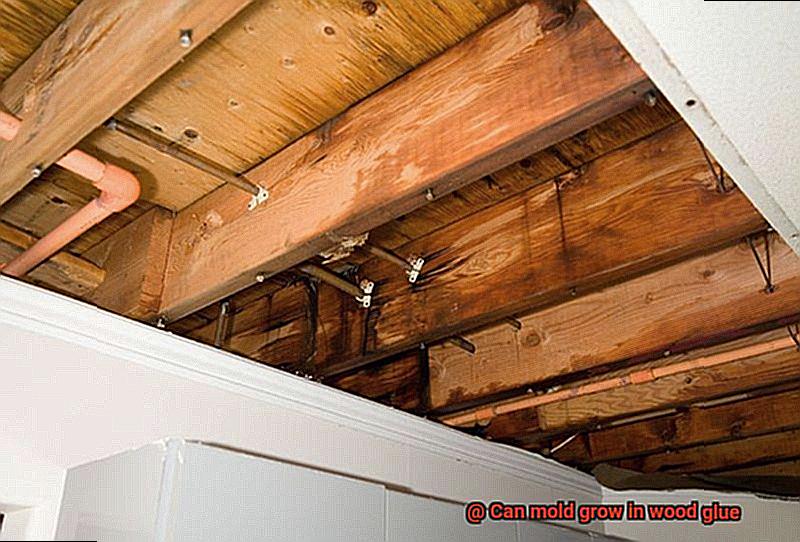
So, how can you ensure proper ventilation and drying? Let’s dive into the details.
Firstly, adequate airflow is key. Open those windows, set up fans, do whatever it takes to get air circulating in the area where you’re applying the wood glue. This simple step will speed up the drying process and reduce the moisture content in the glue, rendering it less susceptible to mold growth.
But airflow alone won’t cut it. Before applying wood glue, make sure the surfaces are dry and free from excess moisture. Grab a clean cloth or sponge and wipe off any lingering dampness or debris. This will facilitate proper drying and minimize the risk of mold taking hold.
Choosing the right location is also paramount. Avoid areas with high humidity levels like basements or bathrooms, as they can prolong drying times and increase the likelihood of mold growth. Instead, opt for well-ventilated spaces with low humidity levels.
Once you’ve glued your surfaces together, exercise patience. Follow the manufacturer’s instructions regarding drying time and resist the urge to rush things. Allowing sufficient time for the glue to dry completely before subjecting it to stress or pressure will ensure its effectiveness and durability.
For larger surface areas, providing additional support is a smart move. Clamps or weights can help hold the glued surfaces together tightly while still allowing air to circulate around them. This aids in proper drying and minimizes the chances of mold taking root.
Even after the glue has fully dried, your job isn’t done. Regular inspections are crucial. Keep a vigilant eye out for any signs of mold growth, such as discoloration or a musty odor. If you detect mold, act promptly by removing the affected areas and treating them with appropriate mold-killing products.
Sealing Bonded Surfaces with Protective Finish
Sealing bonded surfaces with a protective finish is a crucial step in safeguarding against the insidious threat of mold growth in wood glue. Don’t let your hard work go to waste; take action to preserve the integrity of your bonded surfaces. By creating a formidable barrier, the protective finish shields the wood glue from moisture infiltration, effectively thwarting the ideal conditions for mold to flourish.
One popular method of sealing bonded surfaces is harnessing the power of clear epoxy resin. This robust and waterproof material bestows a resilient shield upon the wood glue, not only blocking moisture intrusion but also enhancing the durability and strength of the bonded surfaces. With a vast array of formulations available, including those specifically tailored for wood applications, epoxy resin caters to diverse needs and preferences.
When applying epoxy resin to seal bonded surfaces, meticulous adherence to the manufacturer’s instructions is paramount. This process typically entails blending the resin and hardener in precise proportions, applying an even coat across the glued area, and allowing ample time for proper curing. Once cured, the epoxy resin transforms into an unyielding, lustrous finish that expertly seals the wood glue, banishing any fears of mold growth.
Another viable option for sealing bonded surfaces lies in embracing the virtues of clear polyurethane varnish. Esteemed for its ability to safeguard wood surfaces against moisture, stains, and overall wear and tear, polyurethane varnish forms a transparent protective layer that rebuffs water and other liquids from infiltrating the glue and inciting mold proliferation.
To ensure optimal results when applying polyurethane varnish, meticulous surface preparation is essential. This involves lightly sanding and meticulously eliminating any traces of debris or dust. Armed with this pristine canvas, you can confidently apply the varnish using a brush, roller, or spray gun—simply follow the manufacturer’s guidelines regarding application techniques and drying times. Multiple coats may be necessary to achieve your desired level of protection.
While epoxy resin and polyurethane varnish are prominent contenders in the quest to seal bonded surfaces, other protective finishes, such as lacquer, shellac, and wax, also warrant consideration. Each of these options boasts unique advantages and characteristics, allowing you to tailor your selection to the specific requirements of your project.
ZnQYOOVh6qU” >
Conclusion
In conclusion, the answer to the question “Can mold grow in wood glue” is yes. Mold can indeed grow in wood glue under certain conditions. The organic components present in wood glue provide an ideal food source for mold spores to thrive and multiply.
Moisture is another crucial factor that promotes mold growth, and if wood glue is exposed to high humidity or damp environments, it creates a perfect breeding ground for mold.
Additionally, inadequate ventilation can further contribute to mold development in wood glue. Therefore, it is essential to store wood glue properly in dry and well-ventilated areas to prevent mold infestation.
Regular inspection and maintenance of wooden surfaces bonded with glue are also recommended to detect and address any potential mold growth promptly.

